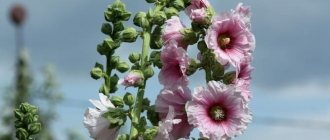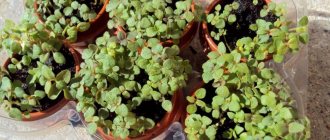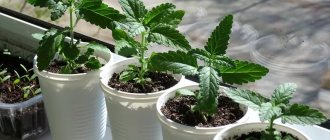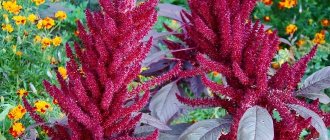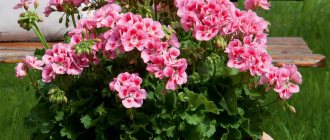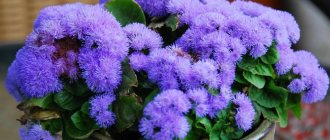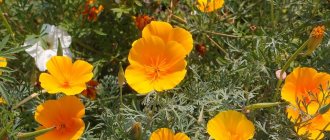Chabot carnation is a very refined, elegant and beautiful flower, among which there are specimens of different colors (red, white, purple, yellow, etc.). The plant is a biennial crop, but in Russia it is grown as an annual. If you love stylish and fragrant flowers, then this crop will definitely suit your taste! It is convenient to get a plant in your flowerbed by growing garden carnations from seeds in seedlings at home.
What varieties of cloves are grown from seeds?
Nature and breeders have developed about 300 varieties of cloves. Not all are suitable for growing from seeds. The most common varieties that are suitable for seed planting are:
- Dutch is a perennial, the main feature of which is considered to be long and abundant flowering, beginning in the second half of July and continuing until the onset of the first frost. Carnations bloom in different shades, but the most popular is red, edged with a white stripe.
- Chinese carnations can decorate any area in the garden or flower bed. The flowers are collected in inflorescences, the colors of which are very diverse and have a bluish tint.
- Pinnate is a small bush with double, densely packed flowers. This gives the variety a zest and unusualness.
- Turkish is an easy-to-care variety, the inflorescences of which on one bush can have different shades. Several inflorescences can form on one plant.
Diseases of Turkish cloves
Table 1. Diseases of Turkish cloves: signs, prevention and treatment
| Name of the disease | Signs | Prevention, treatment |
| Mosaic | Long spots on young foliage. In these places, the leaf tissue dies and holes form. Variegation appears on flowers | Prevention - rejection of infected plants and seedlings. They cannot be treated. |
| Mottling | Not all buds open. The remaining flowers have white stripes and wrinkles. The foliage becomes fragile, traces of chlorosis are visible along the veins | |
| Bushiness | Internodes are shorter than normal, causing dwarfism. An increased number of lateral shoots are formed from dormant axils. Flowering does not occur | |
| Ring spot | Young foliage is affected by chlorotic ring-shaped spots of gray and yellow shades. On older leaves, the center of such spots dies off. The leaves themselves become small, red in color, and deformed. | |
| Rust | The stems and lower part of the leaf blade are covered with light brown growths filled with spores. Infected organs die | Prevention - loose planting, watering at the roots, eliminating milkweed, fertilizing with saltpeter every 2 weeks. For treatment, the drugs Baktofit, Topaz, and Bordeaux mixture are used. |
Turkish cloves are planted not only in courtyards, where the proximity of the plant is important. It is planted next to the same light-loving crops as Alpine aster , Carpathian bellflower , and rudbeckia . These plants have the same care requirements, including watering, fertilizing, etc. If Turkish carnation seedlings are transplanted into a pot, then this flower will decorate gazebos, terraces and rooms, forming small clubs from several bushes.
Turkish carnations decorate living spaces
Photo of carnation flower
When to plant cloves for seedlings, in what month
To get strong and healthy seedlings, seeds begin to be sown at the end of February and finished in mid-April. Such a long sowing period is due to the fact that in this way it is possible to extend the flowering period of carnations in the flowerbed. Those bushes that are planted earlier will begin to bloom earlier, late plantings will bloom after them.
ATTENTION! You can sow seeds throughout the year, but it is better to do this from February to April.
Planting a flower for seedlings depending on the region
Taking into account the timing of planting, it is important to take into account the characteristics of the growing regions. Each region has its own climatic characteristics that can affect the period and abundance of flowering.
In the southern regions, the climate is warm, which allows flower growers to receive seedlings earlier, and, therefore, the bushes will bloom faster.
The length of summer also affects the duration of flowering. In the southern regions, you can plant flowers for seedlings both in February and April.
The climate of the central regions is unpredictable and this can affect the carnation. There is no need to rush to sow here. It is better to start planting in March so that the carnation does not outgrow and form buds before it is planted in the soil. If this happens, the carnation takes a long time and has difficulty adapting, which does not have a very good effect on flowering.
But in the northern regions, where summer is late and short, it is better to sow in mid-March and not delay until April. Late shoots will not have time to form buds and will not bloom at all.
ATTENTION! When planting carnations, weather forecasters' forecasts should also be taken into account. In recent years, the climate in the regions has been changing, and the weather can bring unexpected surprises.
Brief information about the plant
Bred in the 19th century by the French pharmacist Chabot from Toulon, carnations, thanks to their natural beauty, duration and abundance of flowering, very quickly gained popularity not only in Europe, but throughout the world. Retaining its freshness for a long time after cutting, it has become a favorite flower when arranging bouquets.
Surprisingly, the fragile and delicate flower has become a model of severity and solemnity. Not a single festive event is complete without these flowers. And the red carnation serves as a symbol of courage and bravery, and is the personification of victory.
When to plant cloves for seedlings in 2022 according to the lunar calendar
As with planting all garden crops, it is recommended to plant carnations on favorable days, when the moon is in its waxing phase. It is this period that has a beneficial effect on growth, as well as the formation and strengthening of the root system.
Favorable days for planting carnations in 2022 according to the lunar calendar
Favorable days in 2022 for planting are:
| January | 3-17 |
| February | 2-15 |
| March | 3-17 |
| April | 2-15 |
| May | 1-15 |
| June | 1-13, 30 |
| July | 1-12, 29-31 |
| August | 1-11, 28-31 |
| September | 1-9, 27-30 |
| October | 1-8, 26-31 |
| november | 1-7, 25-30 |
| December | 1-7, 24-31 |
When is it not worth planting carnation seedlings in 2022 according to the lunar calendar?
The days when it is better to hold off on planting and do something else in 2022 are:
| January | 2, 18 |
| February | 1, 16 |
| March | 2, 18 |
| April | 1, 16, 30 |
| May | 16, 30 |
| June | 14, 29 |
| July | 13, 28 |
| August | 12, 27 |
| September | 10, 26 |
| October | 9, 25 |
| november | 8, 24 |
| December | 8, 23 |
Use in landscape design
Flowers of the genus Caryophyllaceae are often used to decorate flower beds. Can be planted in single plantings, in combined and mixed groups. Thanks to the wave flowering of different varieties, the shrubs will decorate the area for 2-3 seasons. The perennials form soft, colored cushions of thin, narrow leaves and begin to bloom in early June. Low-growing varieties are suitable for decorating rocky gardens.
In mixed plantings, carnation feels good surrounded by ragwort, yarrow and broom kochia. A successful combination would be graceful gypsophila. It is advisable to avoid proximity to tulips - they can infect delicate flowers with fungal diseases. Decorative varieties take root well in greenhouses and can bloom throughout the year. Open-air terraces and verandas can be decorated with flowers; in combination with wildflowers, they will decorate a rocky garden. The root system of carnations is shallow, so decorative flowers can also be planted in pots and wall-mounted flowerpots.
What you need to plant carnation seedlings
Before planting seeds, you need to think through all the nuances of growing and prepare a substrate, a container for future seedlings and, most importantly, prepare the seeds for sowing.
How to choose the right variety of cloves?
To choose the right type of carnation, you need to decide exactly what you want to see on your site.
Varieties may differ from each other in the shape and color of buds and leaves, the height of the bush, and care requirements.
IMPORTANT! When choosing a variety, you must take into account the growing region and its climatic features.
How to choose seeds for planting
It is recommended to approach the selection of seeds for cultivation wisely and pay attention to the following criteria:
- date of manufacture - expired seeds will not give the desired result;
- the seeds must be ripe, this is easy to understand by their appearance;
- the seeds should not be too small;
- there should not be any raid on them.
What soil is needed for planting carnations?
Any universal soil is suitable for growing cloves, which can always be purchased at a specialty store.
Many gardeners prepare the substrate themselves. To do this, you will need humus, peat and garden soil in equal proportions. It is recommended to add a little sand or perlite to this mixture for looseness.
When preparing the soil substrate yourself, it is recommended to ensure that the acidity is neutral. To neutralize, you can add a small amount of ash to the substrate.
IMPORTANT! The substrate prepared independently must be disinfected. To do this, it can be soaked in a solution of phytosporin or potassium permanganate, frozen or doused with boiling water.
How to prepare seeds for sowing seedlings
Before sowing, the seeds are disinfected. To do this, you can use special immunomodulators or a solution of potassium permanganate.
Place a bag of seeds in a weak solution of manganese for 15-20 minutes, and then begin sowing. This procedure will prevent many diseases.
What not to do when planting cloves
Before sowing, you need to pay attention to the soil moisture; it should not be too high, and under no circumstances should you water the soil immediately before sowing.
Potassium chloride preparations and manure should not be used for feeding.
Vegetative methods of propagation of cloves
You can also grow cloves using vegetative propagation. In addition to seeds, perennial carnation is well grown by cuttings, layering and dividing the bush.
Propagation of carnations by cuttings
Cuttings are used to preserve the carnation variety. To do this, take shoots 10-12 cm long and remove the leaves on the lower part. The finished cuttings are immersed in the soil to a depth of 1-2 cm. After three weeks, the shoots will take root and next year will be no different from the mother plant.
It is important that the soil for germination is light. To do this, add humus, sand or perlite to the peat. And also disinfect the soil with a solution of potassium permanganate. After planting the cuttings, they need to be watered and placed in partial shade.
The fact that the cuttings have taken root can be determined by the renewed growth of the tops. After this, you need to gradually accustom the seedlings to the open sun and feed the plants with complex fertilizers for flowers.
Propagation of cloves by layering
Propagation of cloves by layering
This method is used to propagate garden carnations. This process is best carried out in July. How to propagate cloves by layering:
- Select a strong side shoot of the carnation that has not yet bloomed.
- Remove the lower leaves on it and leave 4-5 pairs of leaves on the top.
- Gently squeeze the stem with your finger so that it bends but does not break.
- Make a cut below the last pair of leaves and slightly bend the resulting tongue.
- Dig the shoot into the soil and secure it with bent wire or a paper clip.
- On such a shoot, the first roots will appear in 1.5 months. Then such a plant can be separated from the parent and transplanted to a new place or pot.
Propagation of carnations by dividing the bush
This method is suitable for propagating and growing Turkish cloves, since its root system is fibrous and superficial. If the division is successful, the flower will bloom the same year. It is recommended to divide the bush in early spring, before sap flow begins.
How to propagate carnations by dividing the bush:
- Dig up the plant and shake the soil from the roots.
- Using a sharp knife, cut the bush into two or three parts, so that at least one leaf rosette remains on them.
- Then use pruning shears to remove dry stems and roots.
- Plant parts of the bushes in the ground and water them regularly.
Planting carnation seedlings at home, step-by-step photos
At home, growing carnation seedlings is available in two ways. Both methods are acceptable and do not require special preparation.
Growing indoors
The first method involves planting seeds early, which affects flowering time. To do this, seeds are sown evenly into a prepared container with a substrate, sprinkled with warm, settled water from a spray bottle and covered with glass until shoots appear. This method is suitable for all regions and is considered less risky.
Growing in open ground
This method is more suitable for warm southern regions, but even there there is a huge risk of getting a bad result.
With this method, immediately after establishing a positive air temperature, small furrows are made in the prepared area and clove seeds are sown. Before emergence, monitor the humidity. If necessary, cover the area with protective material from frost.
Types and varieties
There are several hundred varieties and types of garden carnations. All of them are cultivated as ornamental plants, including hybrids. The names of many species come from the appearance of the flower or where it grows.
- Turkish or bearded. It is one of the most unpretentious varieties and tolerates cold well. This plant comes in different sizes - on average, the height of the shoots reaches 55–60 cm, but there are also low-growing subspecies. A distinctive feature of the species is large inflorescences in which flowers with even or double petals are collected.
- Feathery carnation. This perennial species is the most popular among gardeners. The medium-sized plant is used for landscape decoration and grown in flower beds. Regardless of the variety, the height of the feathery carnation does not exceed 30 cm. A distinctive feature of the species is its ability to grow. The perennial can bloom several times a year, which is why it is used to decorate garden plots and local areas. It stands up well when cut and retains freshness and aroma in bouquets for up to 2 weeks.
- Garden perennial or Dutch. The plant is widely cultivated and used for cutting and bouquets. It belongs to the greenhouse family and is grown everywhere all year round. The species is distinguished by a large number of subspecies of different colors and heights. The length of the stems of tall varieties is 60–100 cm, of medium-growing varieties – 30–60 cm, compact or decorative – up to 30 cm.
- Grass. A wild species that grows everywhere. The height of the stems is 38–40 cm. This species is distinguished by small flowers collected in small inflorescences. The color of the buds varies, pink and red shades are more common. The species does not require careful care and can be grown for landscaping instead of grass on lawns.
- Indian. An indoor ornamental plant that is rarely found in nature. It prefers a warm, humid climate and grows in open ground mainly in Australia, South America and Africa. A characteristic feature of this species are large white flowers collected in inflorescences. Wave flowering lasts up to two months.
- "Shabo." The perennial has large flowers of various shades. Buds of white, yellow and scarlet colors are often found. A distinctive characteristic of the variety is its strong aroma and narrow, short leaves of bright, rich color. Velvety inflorescences on a small shrub are suitable for decorative gardening.
- "Grenadine". This variety is grown primarily for cutting. Carnations with large flowers come in a variety of colors. The homeland of "Grenadine" is considered to be the Mediterranean, but it also takes root well in cooler climates. Cold-resistant and unpretentious variety looks good in flower beds.
- Carnation Andrzejewski. A distinctive feature of the variety are bluish stems without leaves. The petals of the buds are covered with villi and small teeth, which is why it is often called terry. The color of the flowers is usually red, less often pink. Andrzejewski's carnation tolerates temperature changes, lack of moisture and fertilizing well. The plant is light-loving and does not tolerate shade.
- Hybrid. The popular variety is represented by flowers of various shades. It is widely cultivated by gardeners. A distinctive feature is the variegated color - there are specimens with striped petals, specks and spots.
Florists often use carnations in solid, bright colors. Thanks to the wide color palette, different varieties of garden carnations can be used to create various compositions. Let's take a closer look at the best varieties for growing in the garden.
- "Champagne" Terry golden petals emit a pleasant delicate aroma. Flowers with a diameter of 5–7 cm are collected in inflorescences, of which there can be up to 20–25 pieces. Low stems form a neat bush. The variety is suitable for decorating flower beds and for cutting into bouquets. After the buds bloom for a long time (from June to October), it is recommended to bring the plants indoors.
- "Aurora" Medium-sized shrubs have high decorative qualities. On long, erect shoots there are pink buds collected in inflorescences. Dense double petals open in early summer and continue to bloom until the end of October. The cold-resistant variety is suitable for temperate climates, and in the southern regions it can decorate flower beds with bright buds twice a season. Decorative flowers tolerate proximity to other types of carnation.
Throughout the summer, the bushes must be pinched, cutting off all faded flower stalks from the shoots. This will help stimulate the release of new buds. In the future, after flowering has completely stopped, you should cut off all the stems from the bush, leaving about 10 cm above the ground.
How to care for carnation seedlings
Caring for seedlings is simple, and even inexperienced gardeners can handle it.
Caring for cloves immediately after sowing until seedlings emerge
Immediately after sowing, the soil is slightly moistened. The container is covered with glass or any transparent material, creating a greenhouse effect. The container is placed in a bright, warm place until shoots appear, while monitoring the humidity of the substrate.
ATTENTION! The container is ventilated daily, removing the glass for 15-20 minutes so that mold does not appear on the surface of the earth.
Caring for carnations after the entrances appear
After emergence, care consists of periodic watering and fertilizing. The soil is moistened using a spray bottle with filtered or settled water at room temperature. After germination, the glass is removed from the container and the container is placed on a bright window without direct sunlight.
Site selection and soil preparation
Most carnations prefer neutral or slightly alkaline soils; they do not do well in acidic and heavy soils. Flowers grow best on fertile sandy loams and loams, moderately moistened and fertilized.
Plants do not tolerate the application of fresh manure and spring stagnation of water, which has a particularly detrimental effect on perennial species that overwinter in the ground - grass, sandy, spiny and gray carnations .
Read about these and other types of carnations, with descriptions and characteristics of the most popular varieties, in the article “Carnations - the best varieties and hybrids.”
Plants love the sun and thrive in sun-exposed flower beds and garden beds, but can also develop well in the light, sparse partial shade of trellises and pergolas that cover the plantings in the midday heat. This will preserve the flowers longer and allow more lush bushes to develop. At the same time, in the open sun the color of the petals is richer and brighter.
The area for planting seedlings or sowing seeds should be level, protected from the wind, with grooves around the perimeter to drain moisture. During spring planting, the soil is cultivated in the fall, digging with a shovel and adding well-rotted manure or compost in the amount of 8–10 kg per 1 sq. m. m, as well as lime on acidic soils.
It is not necessary to apply other fertilizers, and if in previous seasons the site was fertilized with manure, the soil is simply dug up, removing weeds and remnants of vegetation.
How to care for carnation seedlings
Growing seedlings is not difficult, the main thing is to properly care for them and properly water and fertilize them.
Irrigation scheme
If you water the ground with a sprayer before the shoots appear, then after they appear, watering becomes even more careful. To prevent water droplets from falling on young plants and harming them, it is better to use a syringe.
There is no need to moisturize too much, as this will provoke fungal diseases.
Top dressing
Feeding is carried out at least once every 2-3 weeks. It is better to use complex fertilizers, where the content of all necessary microelements is balanced.
ATTENTION! When applying fertilizers, it is recommended to strictly follow the manufacturer's instructions.
Diseases and pests
Garden carnations are not very susceptible to pest attacks. In dry weather, aphids or spider mites may settle on the bushes. In the first case, systemic insecticides such as Actara can help get rid of parasites. If the infestation is small, two treatments are sufficient. Ticks are more difficult to get rid of. Infected bushes are sprayed 3-4 times at weekly intervals with an acaricide, for example, Neoron. All procedures are carried out in the evening in calm weather.
If there is excess moisture, garden carnations can suffer from root rot, rust and other fungal diseases.
If wet, dark spots appear on the leaves, the buds rot or the bushes wither, the following measures must be taken:
- Damaged plants are removed.
- Spray the remaining plants 2-3 times with systemic fungicides such as Topaz or Fondazol.
To prevent fungal diseases, before heavy rains, plants can be treated with biological fungicides such as Fitosporin.
Flower pick
Picking takes place in two stages. The first time they dive after the appearance of two normally developed leaves, the second time after four leaves have formed.
Picking is carried out according to the following scheme:
- the soil with young seedlings is watered abundantly;
- small drainage holes are made in the prepared containers, after which they are filled with substrate;
- small depressions are made in the ground for the root system of the seedling; they should be slightly larger than the roots;
- The sprout is moved to a new container and the substrate is slightly compacted.
After the plant adapts, you can use growth stimulants.
Planting care
Dianthus caryophyllus var. schabaud
Regular watering and fertilizing, protection from pests and diseases are the main techniques for caring for carnations. In addition, you should remove weeds in time and thin out seedlings during seed propagation - weak young plants develop poorly in dense plantings, and if perennial weeds grow, they may even die.
Watering
Plants are watered moderately; many perennial species tolerate drought well, slightly losing their decorative properties. At the same time, varietal and hybrid varieties with large double flowers require regular watering - every 7-10 days at the rate of 7-8 liters of water per 1 square meter. m.
The next day after watering, loosening is carried out, destroying the crust, or the soil is mulched in advance with peat or humus 5–7 cm thick. This method will save moisture and improve the soil structure.
Fertilizer
Carnation is responsive to fertilizing; fertilized plants have more lush, densely colored foliage and bloom brighter. A week after planting and at the beginning of flowering, complex fertilizers are applied.
The first feeding uses a composition with equal shares of the main elements (nitrogen, potassium and phosphorus) or with a slight predominance of nitrogen. You can fertilize the flowerbed with a mixture of the following composition:
- ammonium nitrate 6 g;
- superphosphate 10 g;
- potassium salt 3 g.
An increased phosphorus content will have a positive effect on the development of the root system. The proposed volume of fertilizer will be enough to feed 10 square meters. m landings. For the same purpose, you can use Crystalon yellow or green
During the bud period, fertilizing with a low nitrogen content and a high potassium content is used. It is enough to carry out two feedings per season. If the Shabot are transplanted into pots in the fall, the plants are fed again in early September.
Disease and pest control
Feather carnation (Dianthus plumarius)
Perennial species of carnations, if the rules of agricultural technology are followed, mainly in the absence of stagnation of water, rarely get sick. During seed propagation at the stage of growing seedlings, varietal and hybrid plants can suffer from fungal and bacterial diseases, and less commonly, viral infections. Of the fungal diseases, the greatest damage is caused by fusarium, alternaria and rust.
Fusarium appears as drying spots with a brown or black surface and a pinkish coating on plant stems, most often at the root collar. When affected by fusarium, leaves and flower stalks turn pale and wither, and the plant quickly dies. To combat the disease, plantings are treated with a 0.1–0.2% suspension of foundationazole, the same drug is poured under the root, and the soil around the plants is sprinkled with dry powder.
Alternaria blight affects leaves and stems and is characterized by the appearance of black spots, further drying out and loss of the affected areas. To combat the disease, use one of the fungicides - copper oxychloride, Ridomil or colloidal sulfur.
When affected by rust, reddish pustules form on the leaves in the form of small tubercles, in which fungal spores develop, spilling out of the pustules as they mature and infecting everything around. Bushes affected by rust are destroyed, and the plantings are treated with Topaz fungicide or copper oxychloride at least two to three times per season. If the lesion is observed in the greenhouse, carry out the same treatments and provide intensive ventilation.
Damage to plantings can also be caused by a variety of pests of garden and flower plants - aphids, mites, caterpillars, mole crickets, wireworms, thrips and others. In case of severe damage, pesticides are used - Decis, Bi-58, Arrivo. For treatments, it is advisable to use harmless herbal preparations based on wormwood, hot pepper, onion, garlic and pyrethrum.
So, when attacked by aphids, thrips, and mites, the plantings are treated with onion infusion according to the following recipe:
- Take 200 g of chopped hot onions and pour 1 liter of boiled cold water (you can add a handful of onion peels).
- The drug is infused for 15–16 hours, strained, squeezed and brought to a total volume of 8 liters.
Planting carnations in open ground
On the site, seed sowing is planned immediately after positive air temperatures are established.
What varieties of carnations are suitable for planting in open ground?
Absolutely all varieties are suitable for this method of planting; you just need to take into account the characteristics of a particular variety and the climatic conditions of the region.
The most popular varieties are: Chinese carnation, pinnate, Turkish and Dutch.
When can you plant carnations in open ground?
Depending on the region, planting of cloves begins in mid-April. When sowing carnations directly into a flowerbed, you need to be prepared for the fact that some varieties will begin to bloom only in the second year.
How to plant in open ground, step by step?
Before planting, it is important to carefully prepare the area; there should be no debris or weeds on it.
- The area must be loosened and, if necessary, fertilizer and ash added to maintain the required acidity level.
- After this, shallow grooves are made, where the clove seeds are sown. It must be taken into account that the bushes will grow.
- The furrows are covered with a 1 cm layer of soil and moistened.
Carnation Shabo - description
The height of the Shabot carnation is from 30 to 70 cm. Its root system is taproot, located at a depth of 10-20 cm. The shape of the bush is reverse pyramidal with a well-defined main stem. The shoots are bare, knotty, round, bluish-green in color. The leaves are also bluish-green, narrow, up to 12 cm long and up to 7 mm wide. Large flowers can be simple, double or semi-double, of various colors, folded, corrugated, curved or deeply dissected. Simple flowers usually have 10 stamens, while double flowers can have up to 30 or more. The fruit of the Shabot clove is a cylindrical multi-seeded capsule with five teeth, pointed at the end, in which small flat black seeds with a rough surface ripen.
The perennial carnation Shabo in our climate is grown as an annual plant. We will tell you how to sow Shabot carnations for seedlings, how to care for seedlings, how to grow Shabot carnations in open ground, how and what to feed them, when to water them, when to pinch Shabot carnations and how to protect them from diseases and pests.
Planting carnation seedlings in open ground
They begin to plant carnations in open ground in May, when night frosts have completely subsided. Despite the fact that cloves are a frost-resistant crop, frosts during this period can provoke long-term adaptation and, possibly, death.
How to choose a place to plant carnations
The area where it is planned to grow flowers should be well lit and protected from wind and drafts.
Where can you plant carnations?
Carnation goes well with many flower crops. They can be asters, delphinium, alpine plants, poppies and other decorative varieties.
How to prepare carnation seedlings for planting in open ground?
Before planting seedlings, they need to be prepared for this - hardened off.
They do this gradually. To begin with, the boxes are taken out into the fresh air for 5-10 minutes. Gradually, the time increases until the plant can be exposed to air even at night.
How to prepare a place to plant carnations outdoors
Before planting, the area is cleared of weeds and other debris. The soil is dug up and complex fertilizers are added there strictly in accordance with the recommendations on the packaging.
How to plant flowers correctly, step by step
Plants are planted according to the following scheme:
- depressions are made in the soil slightly larger than the root system of the flower; you can plant it with a lump of earth from an old container;
- the flower is planted in the prepared hole and covered with earth on top;
- The ground is compacted a little and slightly moistened with settled water at room temperature.
Preparing for sowing
Sowing is an important step in growing Shabot cloves. For successful implementation, it is necessary to properly prepare the soil, seeds and containers for planting.
Seed preparation
Shabo clove seeds have a good germination rate of 85-95%, lasting for 2-3 years. They do not require additional germination and easily sprout on their own. When planting seeds older than 3 years, growth stimulating drugs Epin-Extra (2 drops per 100 ml of water), Zircon (1 drop per 100 ml of water) are used to increase germination.
Seeds purchased in a store usually do not require additional disinfection unless specified by the manufacturer. But planting material collected independently must be disinfected. This can be done using a slightly pink solution of potassium permanganate (soak for 2 hours) or using fungicides: Fitosporin, Baktofit, Fundazol, Vitaros. All treatments are carried out in strict accordance with the instructions.
Soil selection
A properly selected soil mixture allows you to grow healthy, viable seedlings. For Shabot cloves, loose, permeable soil of neutral acidity will be preferable.
It is easy to prepare such soil yourself by mixing garden (turf) soil, humus, peat and river sand in a ratio of 2:2:2:1. Or you can purchase any universal soil sold in gardening stores.
To prevent the development of seedling diseases, soil should be disinfected, especially if prepared independently. The soil mixture can be roasted in the oven for 30 minutes. at a temperature of 70°C, or vice versa, freeze it outside at a temperature not exceeding -10°C for 24 hours, repeating this operation twice.
Soil disinfection is also carried out using disinfectant solutions:
- phytosporin - 2.5 g per 10 liters of water;
- gamaira – 1 tab. for 1 liter of water;
- potassium permanganate – 3 g per 10 liters of water.
Soil treatment is carried out 2 weeks before sowing the seeds.
Simultaneously with disinfection of the soil, sand is calcined, which is recommended to be sprinkled on the sown seeds.
Selection of capacity
A long period of growing Shabot carnations requires repeated replanting, so a common container is used for sowing. The container for planting can be plastic, ceramic, polymer, or wood. To prevent moisture stagnation, the container must have drainage holes, and its height should not exceed 6 cm.
Before sowing, the planting container should be disinfected. Disinfection is carried out with a rich red solution of potassium permanganate. Ceramic or glass containers can be placed in the oven for 30 minutes. at a temperature of 90°C.
